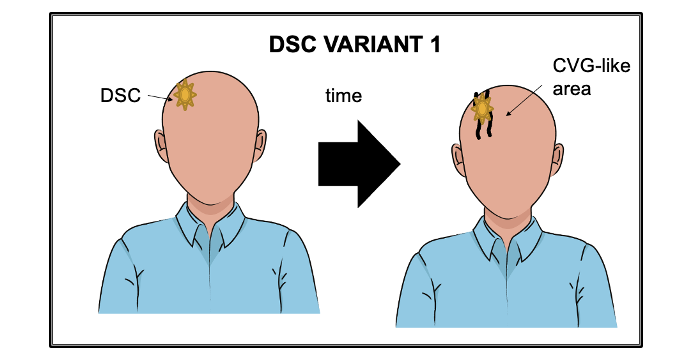4 New Dissecting Cellulitis Variants with "Cutis Verticis Gyrata (CVG)"-Like Changes:
Dissecting Cellulitis can have CVG like Changes
Dissecting cellulitis is a scarring alopecia that presents with nodules and sinus tracts. Patients with DSC may have ridges and furrows that mimic another scalp condition known as cutis verticis gyrata. (For a review of CVG, please see our prior article)
The authors describe four distinct presentations of scalp DC that present with furrows and gyri:
VARIANT 1: DSC in THE FIBROTIC STAGE MIMICKING CVG
VARIANT 2: DSC DEVELOPING AFTER LONG STANDING PRIMARY CVG
VARIANT 3: DSC WITH FORMATION OF CVG-LIKE AREAS ONLY IN DSC AREAS WHEN PRESSURE IS APPLIED
VARIANT 4: DSC WITH FORMATION OF CVG-LIKE AREAS ACROSS ALL SCALP WHEN PRESSURE IS APPLIED
VARIANT 1: DSC in THE FIBROTIC STAGE MIMICKING CVG
The authors point out that the final fibrotic is the stage that shows extensive dermal fibrosis and destruction of sebaceous glands and can lead to cicatricial alopecia. It is these areas of scarring that have the potential to mimic the cerebral gyri, such as CVG. In DSC patients in the fibrotic stage, these folds usually have an asymmetric and random distribution.
VARIANT 2: DSC DEVELOPING AFTER LONG STANDING PRIMARY CVG
The authors provide an example of DSC developing from primary CVG that had been present a long time. This is a new presentation that had not been described yet. The authors hypothesize that the skin folds in CVG could make it susceptible to local trauma by disrupting the skin barrier, thus causing furrows, inflammation, and bacterial proliferation, eventually triggering DC in predisposed patients
VARIANT 3: DSC WITH FORMATION OF CVG-LIKE AREAS ONLY IN DSC AREAS WHEN PRESSURE IS APPLIED
The authors point out that in some cases, the furrows and gyri are not present when examining the scalp but became evident in the area of DSC when pressure is applied to the scalp. This is called a positive Jacquet’s sign. The authors postulate this means there is an absence of follicles.
VARIANT 4: DSC WITH FORMATION OF CVG-LIKE AREAS ACROSS ALL SCALP WHEN PRESSURE IS APPLIED
The authors point out that in other cases, the furrows and gyri are not present when examining the scalp but became evident across the entire scalp when pressure is applied to the scalp. This indicates hypermobility and laxity of the tissues. The authors propose that this may indicated an interconnectness of lesions but this needs more study.
Conclusion
All in all, the authors introduce these 4 CVG-like variants of DSC in order to help prevent misdiagnosis.
REFERENCES
Cajas-Garcia MS et al. Distinct presentations of scalp dissecting cellulitis manifesting with furrows and gyri. J Eur Acad Dermatol Venereol. 2023 Feb 3.
Alzaid Mohammed et al. Cutis Verticis Gyrata and Quality of Life: Clinical Report of 13 Cases. The Egyptian Journal of Hospital Medicine (October 2021) Vol. 85 (1), Page 2995-2998 2995
This article was written by Dr. Jeff Donovan, a Canadian and US board certified dermatologist specializing exclusively in hair loss.





